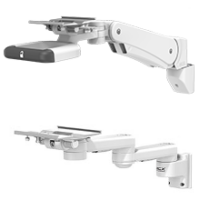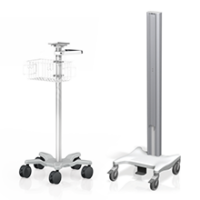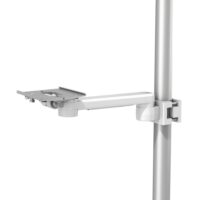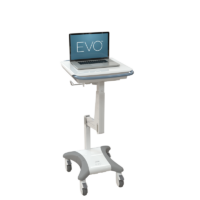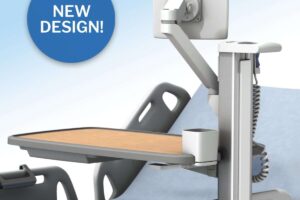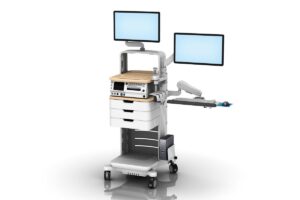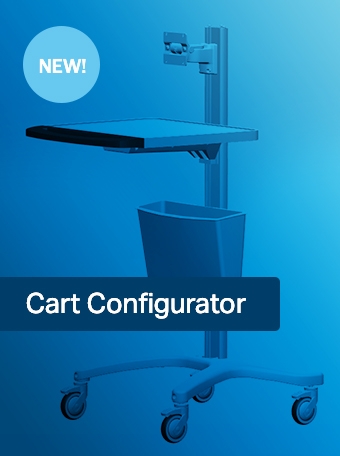
-
Solutions
Solutions pour l'espace de soins
Standardisez les solutions de montage GCX dans l'ensemble de votre établissement de santé.
Solutions informatiques et DME
Solutions de montage pour les équipements de technologie de l'information et de dossiers médicaux électroniques.
Solutions de montage en fonction de votre emplacement.
Solutions pour les dispositifs médicaux
Solutions de montage conçues spécifiquement pour vos appareils médicaux et de surveillance des patients.
-
Produits
Accessoires
- 10 x 25 mm Rails
- Blocs multiprises de qualité médicale
- Boîtiers montables pour tablettes
- Canaux
- Gestion des câbles
- Intégration des tablettes
- Modules de charge USB
- Montage de la coupelle de la sonde
- Paniers et bacs
- Plaques d’adaptation VESA
- Plaques et plateaux pour clavier
- Plateaux
- Poignées
- Postes en bas
- Support pour bouteille de gel
- Supports de caméra
- Supports PolyQuip® pour poteaux et sacs I.V.
- Supports pour blocs d’alimentation
- Supports pour bouteilles de gaz
- Supports pour dispositifs de capture de données
- Supports pour lecteurs de codes-barres
- Supports pour onduleurs
- Supports pour UC
- Tiroirs
-
Services OEM
Les solutions de montage pour les partenaires OEM de dispositifs médicaux vont des produits prêts à l'emploi aux produits entièrement personnalisés.
Approche
Modalités
- Autres modalités
- Ventilation
- Échographie
- Suivi des patients
- Télémédecine
- Navigation chirurgicale
- Solutions ECG
Notre expertise
-
Soutien
Support technique
Contactez notre équipe d'assistance ou consultez la documentation pertinente sur le produit.
-
À propos de GCX
Aider les fabricants d’appareils d’ECG à créer des flux de travail optimaux
janvier 28, 2020 En Appareils médicaux, Solutions de montage médical, Solutions sur mesure
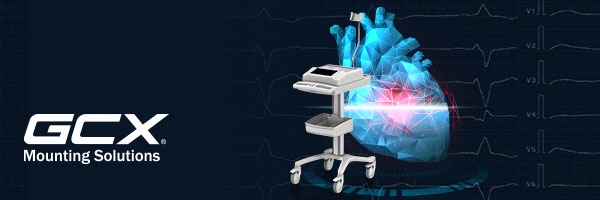
The cardiograph is a staple medical device within health organizations. Better known as an EKG or ECG, this common diagnostic tool is used to detect heart defects or monitor cardiac conditions during and after a health event.
Whether used with remote monitors during stress tests or electrodes tethered to a bed- or chair-bound patient, it’s important that displays on these devices be easily read from any angle, and that all accessories and any paper readings be properly contained. That’s why GCX works with ECG manufacturers to ensure the workstations supporting these devices and accessories provide optimal workflows.
ECG manufacturers typically deliberate the electronic workflow of the device to avoid any disruption in transmissions. But assessing physical workflows is equally important, especially in critical care environments.
Some of the main considerations that GCX utilizes when developing ECG/EKG mounting solutions are:
Mobility: Will the cardiograph be used constantly and moved throughout the hospital in the course of a shift, or is it used intermittently within one department? How easily does the cart holding the device move over different flooring and around other equipment or furniture in the room? What type of casters work best to facilitate quickly moving the workstation down a hallway? Or to make small positional adjustments in a tight area? Are there easily accessible handles to make maneuverability even easier?
User interface: It’s important that users be able to easily and ergonomically interact with the ECG machine and auxiliary devices. This means ensuring a mount allows a technician or physician to easily view screens and paper readouts from either a sitting or standing position. We’ve noticed that more healthcare providers now lean towards tablets and other touch-based form factors; does your medical manufacturing partner provide enclosures for these smaller screens?
Storage: Related to the mobility requirements of the cart, does a user need to store a full day’s worth of supplies on the cart, possibly including electrodes, wipes, gloves, spare batteries and paper? How frequently are these various supplies accessed and what’s the best way to store them? Do ancillary devices such as barcode scanners, card readers, or suction systems need to be mounted?
Cable and lead management: How will the main AC power cord be managed when not in use? ECG devices also require long patient leads and often a module positioned close to the patient’s body to accurately record cardio activity. Especially when used for stress tests involving a treadmill, stationary bike or other exercise equipment, it’s important that these leads and modules be in close proximity to work as intended without intrusions or disruptions, but then be properly stored between exams.
Paper tray management: How is a paper tray configured to collect paper? Technicians will frequently make notes on the readout, so the paper cannot be left to spill off the side onto the floor. Managing these needs is essential to clinician productivity and a positive user experience.
Infection control: Does the ECG workstation use medical-grade materials that meet strong sanitation protocols? Is it designed to allow for easy cleaning of all parts, particularly bins that could harbor germs? Infection control is important. Not only can it be costly under new value-based insurance plans, but more importantly it poses real risk to patients. Having cleanable surfaces that prevent the spread of germs is of utmost importance, especially when in some use cases an ECG/EKG cart may see upwards of 20 patients per day.
ECG technology is moving from long patient leads to wireless connections, and from paper printouts to electronic recordkeeping. Device aesthetics are generally moving toward simple shapes and clean lines, and a cooler color palette. The contemporary design aesthetic quietly communicates professionalism to patients, and signals that the hospital is applying modern technology.
Device manufacturers who collaborate with us gain valuable engineering expertise from our almost 50 years in this business. We have a broad set of skills, materials and tools to draw from. One recent collaboration for the GE Mac VU resting ECG workstation led to a body made entirely of injection-molded hard plastic. This was an unconventional and innovative approach for an ECG machine, but we had the engineering and manufacturing expertise to make it happen, and much more quickly than vendors with limited range or provisions.
Another big benefit of working with GCX is the speed with which you can bring an ECG product to market—in just a few months in many cases. We are experts at ergonomics and clinical workflows and have a robust set of pre-engineered standard components, so that we can provide high quality and cost-effective finished products with minimal tooling.
Call us today to learn how we can help your next project.
Recent Blog Posts
- Bring IT décembre 13, 2023
- Everything within Arm’s Reach: Fetal Monitoring Workstations Nurses Love août 11, 2023
- Ready to Move on from Wooden Carts? mai 16, 2023
- A GCX Superpower: Knowing How to Save You Time janvier 19, 2023
- Configuring Anesthesia Workstations for Safe, Long-Term Usage novembre 8, 2022




















